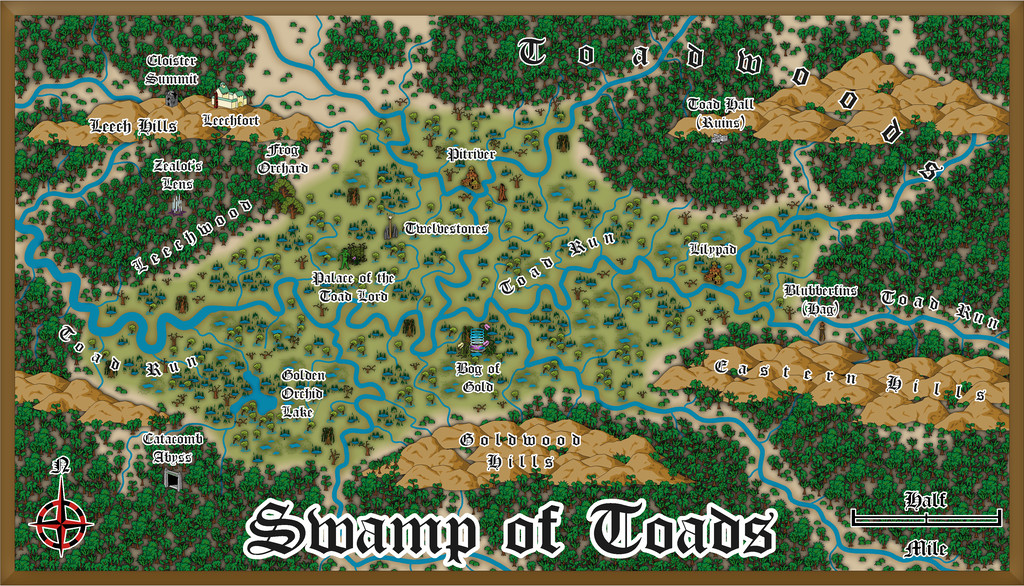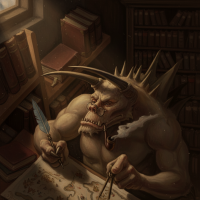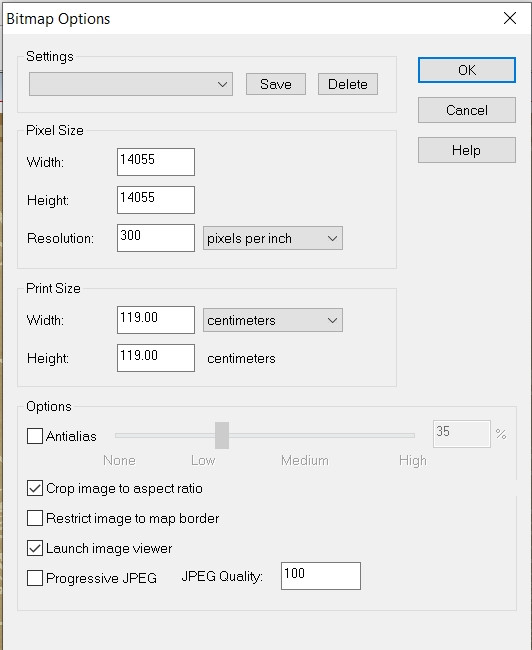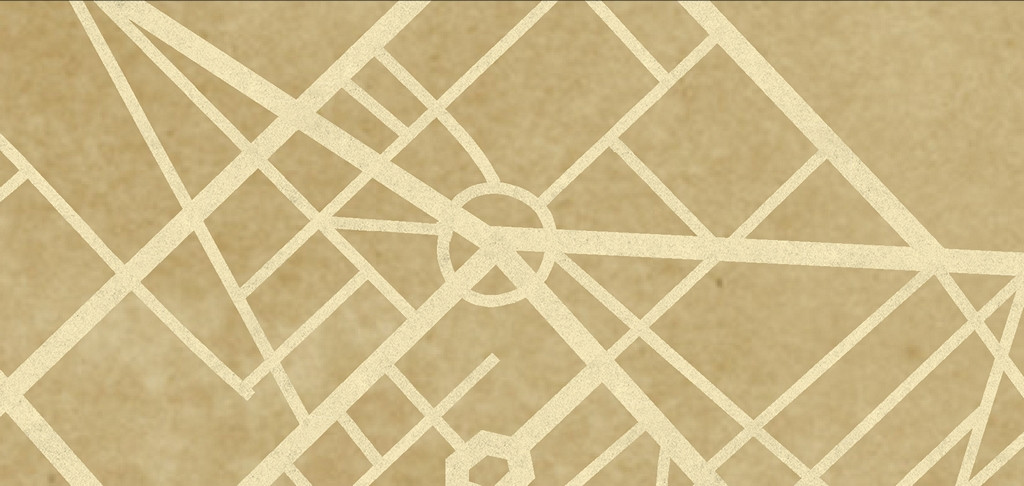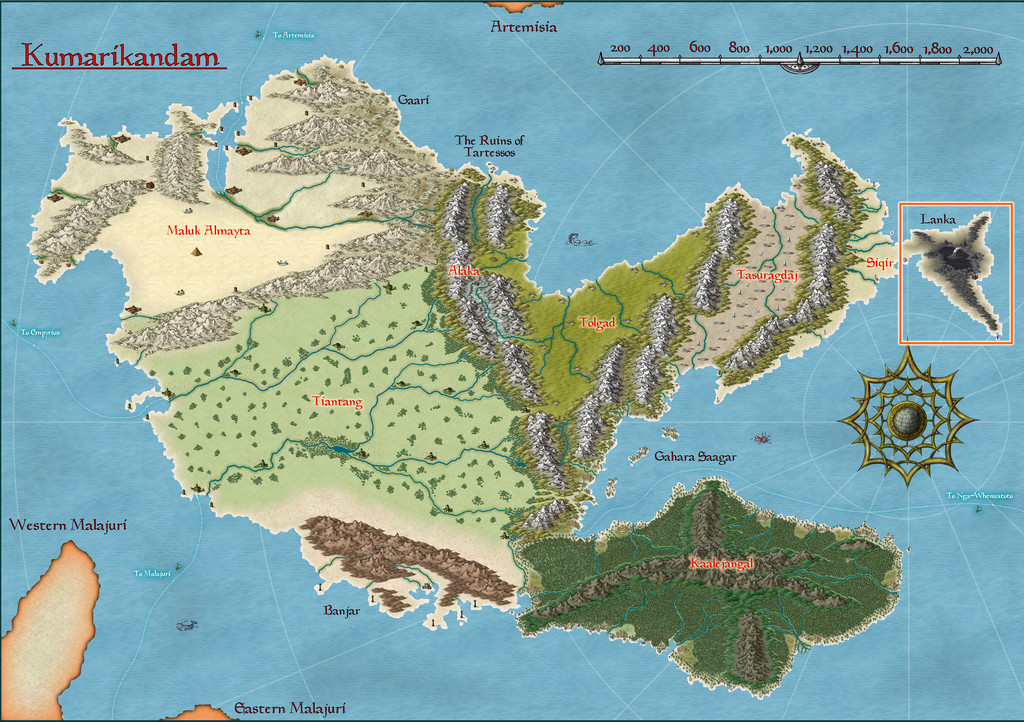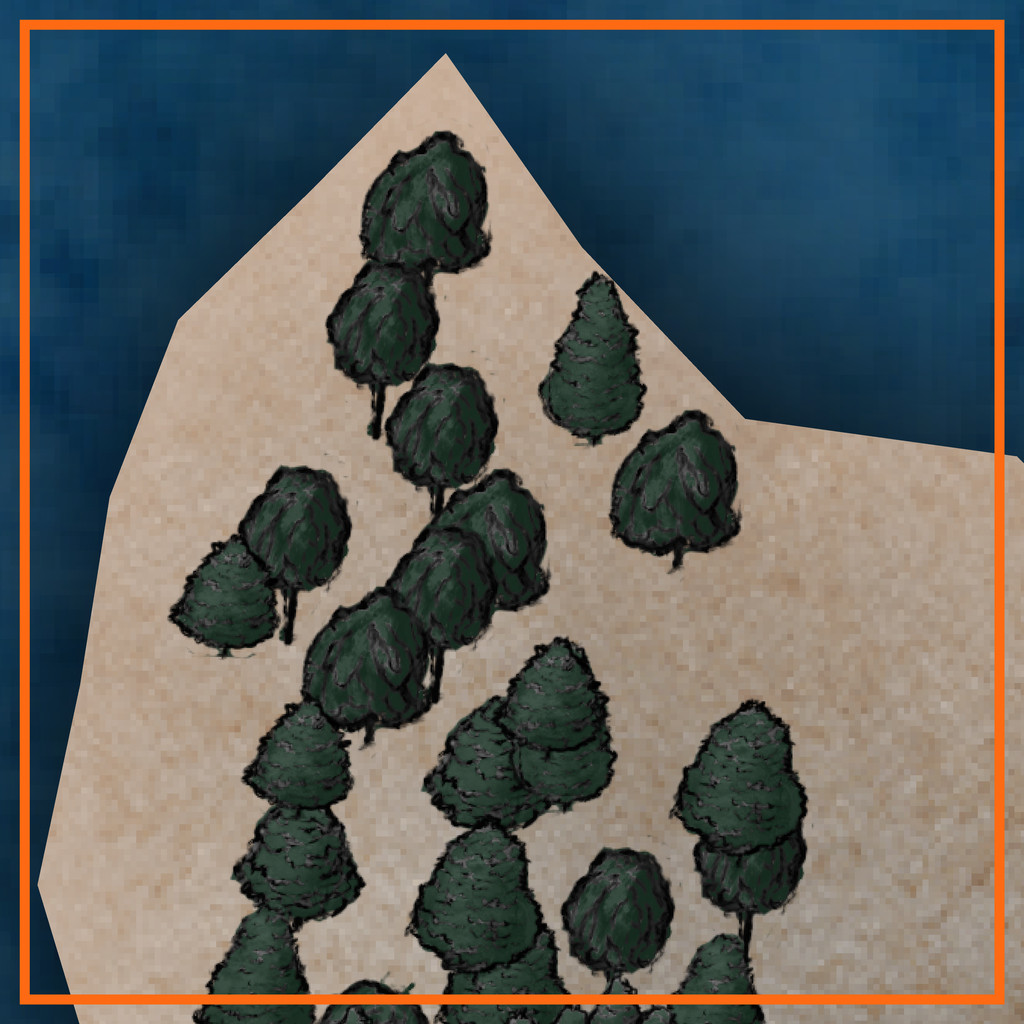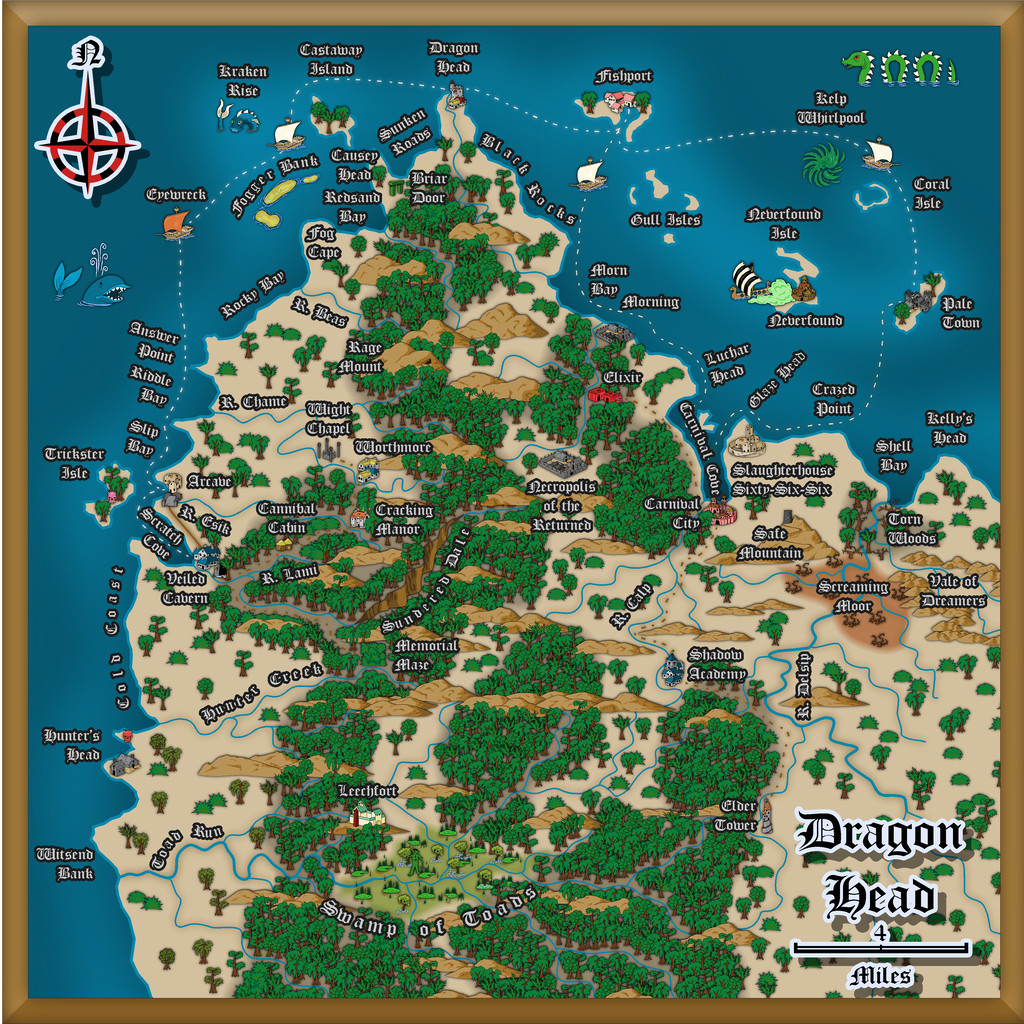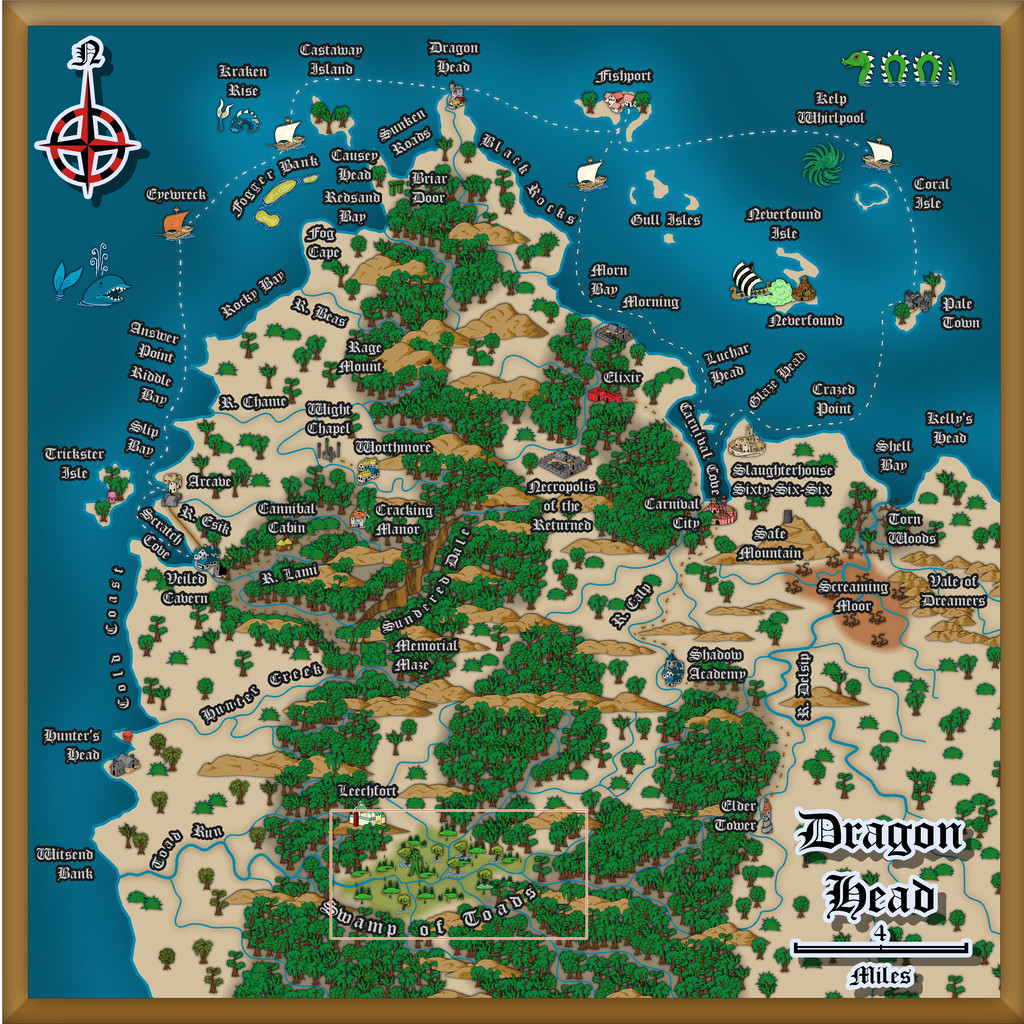
Wyvern
Wyvern
About
- Username
- Wyvern
- Joined
- Visits
- 3,151
- Last Active
- Roles
- Member
- Points
- 5,378
- Rank
- Cartographer
- Badges
- 24
-
Community Atlas: Dragon Head, Lanka, Kumarikandam
Having succumbed to expanding this map-group to three, I set-to randomly allocating some extra places to the Swamp of Toads, beyond what was there already, though not too many, as the area involved is just six miles by three. I toyed with the notion of changing the mapping style for it as well, but the symbol options were just so much greater using the CA140 and SS1 styles than others I'd thought to try, that I chose to stick with them:
Drawing the twisting river lines was rather fun. Indeed, I had to calm down some of them with redrawing, as while accurate to such things in reality (take a look at some of the historical maps showing how the lower Mississippi has appeared and changed over the years!), it made this map look too messy and hard to read. I also dropped the idea of drawing oxbow lakes alongside the channels for the same reason, plus some of the swamp symbols come with little pools anyway, which worked just as well to hint at such elements, while not looking too cluttered. I did have to add one larger lake from the random design process, though that was big enough not to be a problem.
Many of the features came from a variety of the Story Engine decks again, including the three main ones, "The Story Engine", "Deck of Worlds" and "Loremaster's Deck", and several of the fantasy and horror supplementary decks, but this time added to from tables in the main Shadowdark RPG rules, and the free PDF adventure pack "Shadowdome Thunderdark", both available from The Arcane Library.
Within the Swamp is much monstrous flora, both in size and nature, and the place has been generally little-visited by outsiders for centuries, other than a few folk from the Leechfort martial arts school on the Leech Hills (yep, there are giant leeches here as well as toads!). Most of the intelligent creatures here are humanoid Toadfolk, many of whom live in separate homesteads or small communities scattered over the Swamp and nearby jungles. Then there's a gigantic, deity-like Swamp Elemental, commonly known as the Toad Lord, who lives near the heart of the Swamp. And that Palace was what the dice-design dungeon map was soon to become! (Next time!)
-
Ricko's Questions
Ricko asked: I'd like to know how I can export the file in the highest quality possible, since exporting with JPEG Quality gives me a small, pixelated file on the street lines when I zoom in below 100%.
This will be for an A0 print.
I tried a couple of tests using the "Save As... - Rectangular Section JPG" option in CC3+.
Ordinarily, I use a small amount of antialiasing on JPG exports, generally 30% to 35%, and forgot to turn that off, which meant the export failed! So I tried again with Antialiasing turned off.
I suspect the single key thing is to ensure the final export size is set to for A0 paper, so I turned that up to 119 cm. This is my settings pane:
And then I ran the export. The final file size is about 66 MB, but this is a sample zoomed-in to be 100% and then resaved as an image the Forum will accept (so it's smaller than the true 100%). However, when I was zoomed-in at that level, there was no pixellation whatsoever on the roads. This is that smaller image, but using the above settings:
I think all you really need do is ensure the final image size matches the paper size you want the export for print to be - A0 in this case. Good luck!
-
Community Atlas: Dragon Head, Lanka, Kumarikandam
A good deal later than I'd hoped, delayed thanks to various events outside my control, the next batch of maps for my sort-of Dungeon24-25-2... project are finally completed, covering aspects of a small peninsula on the northern shores of the easternmost Peninsula of Lanka, Kumarikandam:
Lanka's pre-existing Atlas notes described it as an ashy, blackened, barren, volcanic wasteland, home to demons, dragons, dwarfs and assorted other (probably inimical) humanoids. However, peering closely at the Atlas map for the peninsula, there are a few spots with trees, shrubs and other hints of vegetation, some of which have settlements marked nearby, so it's not entirely desolate. And it was one of those vegetated headlands that I finally settled on mapping, from this extant base (extracted from the map above):
That orange-outlined area is some 20 miles square (30 km or so), to give an idea of scale.
A group of locations where sites of interest could be placed, were randomly assigned, much as usual, and then ideas for what they might be were drawn from, or inspired by, prompts from The Story Engine's "Deck of Worlds" and its expansion card sets, with some from the main "Story Engine" deck and its expansions too, including "Worlds of Blight & Shadow", "Written in Ash & Bone", "Worlds of Myth & Magic", "Worlds of Tide & Tidings", "Heroes' Quests & Fools' Errands", and the "Story & Worlds Bridge Expansion". From which you can tell I was leaning heavily into the "doom and disaster" concepts from the previous map's notes...
With that completed, the map was starting to come alive more, which, thinking about its geographic location - right on the equator - helped firm-up further. I was tempted to run lines of low hills into the gaps in the pre-mapped wooded areas, on northeast-southwest lines, only to decide against that (although hints of that still survive in the final map) as some of the ideas that had begun to coalesce favoured more west-east lines instead, partly based on what and where the random features were placed. These also gave rise to a number of offshore items, many of which were turned into islands too small to be shown on the original (honest!).
Thinking of what mapping styles might work best for this generally "threatening" area brought me eventually to the Dark Fantasy Maps style (CA140), to which were added items from the SS1 Fantasy Color style too, as suggested by the CA140 PDF Mapping Guide. After which, mapping commenced:
To keep things nicely confusing, "Dragon Head" is the name of this whole peninsula area, a coastal village settlement on the peninsula's northern tip, and the name of that headland where the village is sited! More hints of oddness feature in other map names, which the PDF map notes in the Atlas expand upon, as usual. There are definitely Dwarves, Demons, (Demi-?)Gods, Cannibals and Undead in places though, not all necessarily in what might be considered typical forms, along with still weirder things...
Speaking of which, the jungles have been kept deliberately off the hills for a couple of reasons. One is to further enhance the slightly uncomfortable feel of the whole area - rainforest jungle, but maybe the rain here isn't so healthy as it might be (the locals say it's often so heavy, it strips anything less tenacious than grass from the uplands). Plus the land has been tainted by events elsewhere across Lanka that laid waste to so much of it. The other main reason though was because when designing this map, I was also reading a couple of books on the Guadalcanal campaigns of 1942-43 in the Solomon Islands. Those islands are covered in tropical rainforest jungles, yet on Guadalcanal, as period photos clearly show, the hills are bare of anything much larger than scrubby bushes and grass, including from before any fighting began there. That contrast was just so unnervingly striking, it seemed very apt to reuse it here.
The dungeon map was originally going to be located on the western flanks of the narrow, crevasse-like canyon of Sundered Dale, near this map's centre. However, I found I was struggling to find reasons to so-locate it, and exactly how it was going to work there, because part of the design from the Inkwell Ideas Dungeonmorph Dice showed a large clump of trees in an open air circle, in the centre of a large, partly-roofed, temple-like chamber.
Inspiration for where else it might be placed, and just what it might be, came unexpectedly during a YouTube livestream on Free RPG Day 2025 by The Story Engine, creating settings with various guests using their card decks and expansions. One feature option that wasn't immediately spotted by the streamers was "Fence of Toads", and as so often in the live chat, we went off on our own little tangent about that... Then the stream's organiser, creator of The Story Engine decks, Peter Chiykowski, spotted our tangential chat about the point where I'd mentioned I'd then very recently been designing a "Swamp of Toads" (for this Dragon Head map). He said he'd love to see that, half-jokingly, and so was born the decision to expand the Swamp of Toads into a complete, separate Atlas map!
In case you can't spot the Swamp immediately on the map above, it's here, and we'll find out more about it next time:
-
Interesting Political Take on the Mercator Projection
Interesting broader discussion here. The earliest surviving topographical (known-)world maps tend to show the map creator's country/city in the centre, and many are circular around that point. Wikipedia's Early World Maps page has some useful illustrations in this regard. While that may have had a political motive, there's also an eminently practical one, because then you're able to draw the world moving out from where you started.
Into the medieval period, European maps often had the eastern end of the Mediterranean as their central point, because of its significance for the dominant Christian religion there at the time, and were drawn as circles or ovals out from that area.
If the region around your home site ends up larger and more detailed, that's at least as likely because you'll have more, and far better, information about that area than any other, which you might visit - if at all - maybe once in a lifetime for a few hours to days, in ancient to medieval times. So there doesn't always need to have been a political-patron motive there, significant though that undoubtedly was for some early cartographers.
Maps for planning intercontinental aircraft journeys are still prepared with the originating airport at the centre, and extend out in a circle from there, for instance, to allow the selection of the great-circle line required to reach the destination in the minimum of time, using the least fuel possible.
-
Seeking: Feather, scale fills
Royal Scribe asked: Storyweaver Highspace has some scale fills that might work (along with some other really fascinating fills -- has there ever been a Live tutorial using that annual?)
The creator of the HighSpace style, Joe Sweeney, did a series of tutorial videos when this was released (so for CC3, not CC3+), which are still available on YouTube. There is a link in the CA70 HighSpace 2 PDF Mapping Guide (there isn't a Guide for Part 1), but it goes to the wrong place. This link though takes you to the right place on the ProFantasy site, where you can download the videos. If you'd prefer to watch them online, they're here instead on YouTube.



